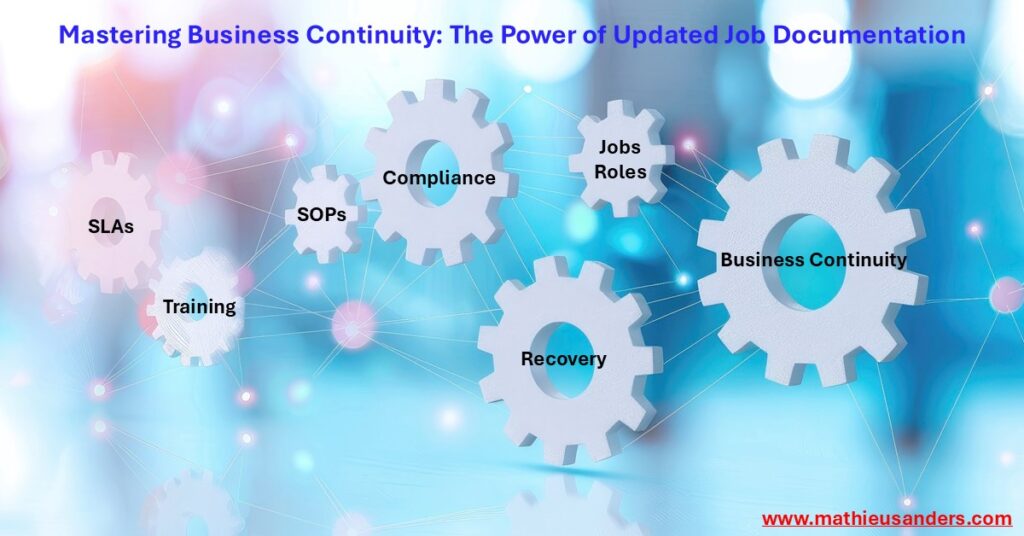
Estimated reading time: 5 minutes
Business Continuity Best Practices: The Power of Updated Job Documentation
Operational resilience has become a top priority for businesses today, making an effective Business Continuity Program (BCP) essential. Updated job role documentation is key to building resilience, enabling smooth recovery, and maintaining operational consistency during disruptions. As a cornerstone of any strong BCP and a key element of Business Continuity Best Practices, it ensures that even the best continuity plans don’t falter, avoiding chaos and lost revenue. This article builds on insights from my previous piece, Job Role Documentation Reference for Leaders, to highlight updated documentation’s critical role in ensuring seamless continuity and long-term success.
Operational Philosophy: “Train How You Fight”
One guiding principle of effective business continuity planning is to design continuity strategies that mimic the operational state. This philosophy, “Train how you fight,” emphasizes that during an undesired event, employees should continue doing what they know best—their regular work. Confusion arises when the continuity process diverges from day-to-day operations, increasing the likelihood of errors and delays that become lost revenue.
This principle is best supported by using role names instead of individual names in continuity plans. Plans tied to specific individuals risk failure if those individuals are unavailable during a crisis. By focusing on roles, organizations ensure that anyone trained for a role can step in, creating a depth of bench and enabling the flexibility to scale operations, such as switching to 24-hour shifts to meet customer demands. DRII’s Professional Practices
Key Documents Supporting a Strong BCP
- Competency Framework: This document outlines the skills and competencies required for each role. It ensures that all team members in a specific role meet the same standards, whether during regular operations or a continuity event.
- Training and Development Plan: Regular training aligned with job roles ensures employees are prepared to perform their tasks under normal and continuity conditions. Training plans also highlight areas for skill development and building resilience within teams.
- Performance Management Framework: Metrics for assessing performance provide actionable insights into role readiness and effectiveness.
- Standard Operating Procedures (SOPs): SOPs ensure consistent task execution. They must be identical for operational and continuity states to prevent errors caused by unfamiliar processes.
- Role Compliance Checklist: This checklist guarantees that individuals in a role meet all regulatory, legal, and internal compliance requirements. Updated checklists reduce the risk of non-compliance during a crisis.
- Tools and Technology Inventory: A detailed inventory of the tools and technology associated with each role helps ensure quick resource restoration during an outage.
- Succession Planning Worksheet: This document identifies backups for critical roles, ensuring continuity even if key personnel are unavailable. Organizations maintain operational capacity during incidents and exercises by training multiple people for the same role. Forbes
Lessons Learned: A Real-World Example
The importance of updated job role documentation became painfully clear during one recovery exercise. A network administrator deviated from documented procedures—which differed from operational practices—and inadvertently corrupted the organization’s Active Directory. As a result, all Domain Controllers had to be rebuilt, turning what should have been a quiet end to an exercise into a major incident that disrupted regular business operations and took a week to correct.
This incident underscores the need for continuity procedures to mirror operational ones as closely as possible. Employees should practice the same tasks during exercises as during a real event to ensure smooth execution and prevent unnecessary complications.
Overcoming Documentation Challenges
Maintaining up-to-date documentation is no small feat. Common challenges include:
- Low Priority: Documentation updates are often deprioritized amidst competing demands.
- Resistance: Employees may resist updating or using documentation.
Solutions:
- Training Integration: Encourage managers to use job role documentation for onboarding and training new employees. This practice not only reinforces the documentation’s importance but also makes it a living, breathing part of operations.
- Incorporate Documentation Status into Scorecards: Add job role documentation’s recency and accuracy to the Business Continuity Score Card reviewed with senior leaders. If documentation is outdated, it lowers the score, leveraging leadership peer pressure to prioritize updates. Forbes: Technology’s Role In Business Continuity
- Annual Management Sign-Offs: Require management to review and approve all role documentation annually. This will enforce accountability and ensure documents remain current.
- Governance Reporting: Report out-of-date documentation to Governance and/or Audit committees. This creates organizational pressure to prioritize updates.
Actionable Insights for Practitioners and Leaders
For inexperienced practitioners:
- Start by aligning continuity procedures with operational SOPs. Avoid introducing deviations that could confuse employees during a crisis.
- Focus on documenting roles, not individuals. Train multiple employees for each role to build redundancy.
For leaders:
- Use updated documentation to strengthen strategic conversations with senior management. Emphasize the role of accurate documentation in reducing risk and ensuring operational resilience.
- Champion the “Train how you fight” philosophy to align continuity plans with business operations and ensure smoother transitions during incidents.
Conclusion
Updated job role documentation is more than a compliance checkbox; it is the backbone of an effective Business Continuity Program. By ensuring documents like SOPs, Competency Frameworks, and Succession Planning Worksheets are current and aligned with operational practices, organizations can mitigate risks and recover efficiently. Practitioners and leaders alike must champion these practices to create resilient organizations prepared for any disruption.
As a seasoned Business Continuity practitioner, I have seen firsthand the consequences of outdated documentation and the benefits of a robust, role-based approach. By investing in updated job role documentation, you’re not just planning for continuity—you’re ensuring the survival and success of your organization.
Book a Call today! Let’s discuss your continuity challenges and how to overcome them.